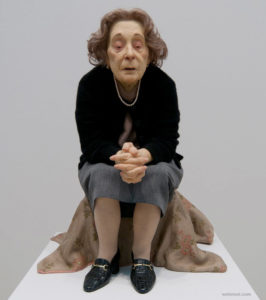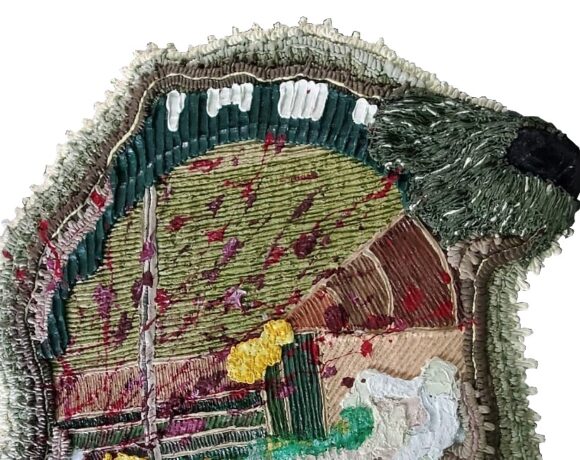Whatever the recovery and when the restoration of some forms of normality will take place, including the start of the new school year, one cannot ignore the immediate reflection on what happened in the world and in Italy. Specifically, a huge and disturbing number of elderly people died in the RSA.
Talking about the mature age as old age, at least before the Covid-19 pandemic, did not fall into the “glamor” categories, indeed it was part of an unsolved contemporary taboo.
Instead talking about the poetics of wrinkles through contemporary art means telling the lost value of our memory, building the present and anticipating the future. And it should be done right from school. With a name, an artist: Ron Mueck.
Yes, he gave testimony to the yielding skin full of history, to the solitary white hairs that adorn the face, to the frightened and fragile gaze of those who keep time but fear it.
He did it with huge sculptures. Perhaps, the artist himself could not have imagined, already in the conception stage, how much his visions, especially today, can be almost a warning for all of us observers and for current history.
Mueck was born in Australia in 1958 and now lives in Britain. He started working in television studios for the creation of life-size puppets and then he also landed in the cinema, distinguishing himself for his strong mastery for special effects.
In 1997 he created a large sculpture “Dead dad” – dead Dad – with raw silicone, perfectly imitating the surface of the human epidermis.
The result is amazing. In more than twenty years, Ron Mueck has created more than thirty-five works of enormous size, becoming one of the most appreciated artists in the world. Even if the author himself has declared that he is fascinated by the art of the Renaissance, there is no ideal of beauty, but the perfect and plausible translation of reality, without any idealization.
Certainly his fame has grown thanks to important collaborations such as those with Cartier and with Charles Saatchi, founder of one of the best known agencies in the world such as Saatchi & Saatchi. But what is most interesting, especially today, is to retrace and gaze through his gigantic sculptures representing figures of the elderly.
In the posture of his “Old Woman”, the weight of time is enclosed in the eyelids and in a gaze between devotion and prayer, bewilderment and annihilation.
On the other side of the vision, there are us who look at the work: stunned, troubled, upset and aware of experiencing, in reality, a tragedy – at least in Italy – without equal. A pandemic that wiped out the lives of over ten thousand elderly people. They, the elderly, are wisdom and memory, patience and virtue, root and comfort.
Look at Mueck’s exceptional artistic ability in breathing hyper-realistic sculptures such as “Grandmother and granddaughter”, “Dead elder”, “Old couple by the sea”. A perfect synthesis of delicacy in the fragility of the epidermis, which imprints furrows on the skin, transmitting a sense of tenderness and disorientation to those who look at them because, in addition to being impressively giant sculptures, they seem to occupy a role of marginality.
This is the paradox that comes out of it: Mueck made them giants, but their posture, their way of looking is not as presumptuously intrusive as their own sculptural form. It is up to those who watch them to redeem this liminal role and give the figures of the elderly a central, founding value of our being in the world.
A great lesson must be collected in the vision of Mueck’s works: his elders are part of the story of each of us: they are grandparents, parents and tell where we come from. It’s up to us to redeem their margins.
And it is precisely the school that can take this opportunity to give young people a great lesson. And start from here.
If Mueck redeemed them, perhaps unconsciously, with these gigantic sculptures, we have the duty of memory, loving consideration and the protection of our elders to put them at the center of our lives.
If covid 19 has dramatically stolen the possibility of breathing, let’s make them part of a symbolic breath of memory: central, gigantic and surprising. Bigger. Hugely larger than Mueck’s sculptures.
Nilla Zaira D’Urso
 Ron Mueck, Couple Under An Umbrella (detail), mixed media, 2013 Courtesy Hauser & Wirth
Ron Mueck, Couple Under An Umbrella (detail), mixed media, 2013 Courtesy Hauser & Wirth
 Ron Mueck, Untitled (Seated Woman), 1999, mixed media, Collection of the Modern Art Museum of Fort Worth. Photo by Kevin Todora
Ron Mueck, Untitled (Seated Woman), 1999, mixed media, Collection of the Modern Art Museum of Fort Worth. Photo by Kevin Todora
 Ron Mueck, Two women, 2005. Polyester resin, fibreglass, silicone, polyurethane, aluminium wire, steel, wool, cotton, nylon, synthetic hair, plastic, metal, ed. 1/1. National Gallery of Victoria, Melbourne. Purchased, Victorian Foundation for Living Australian Artists, 2007
Ron Mueck, Two women, 2005. Polyester resin, fibreglass, silicone, polyurethane, aluminium wire, steel, wool, cotton, nylon, synthetic hair, plastic, metal, ed. 1/1. National Gallery of Victoria, Melbourne. Purchased, Victorian Foundation for Living Australian Artists, 2007

Through art she feels the need to get closer to nature, deciding to create an artistic residence on Etna as a “refuge for contemporary art” for artists and scholars. Thus was born Nake artistic residence. She won the Responsible Etna Award 2015. In 2017, she was invited to the Sala Zuccari, Senate of the Republic, as an art critic. She writes for Italian and foreign artists. Curator of the first Museum of Contemporary Art of Etna and of the “Contemporary Etna” project.






NO COMMENT